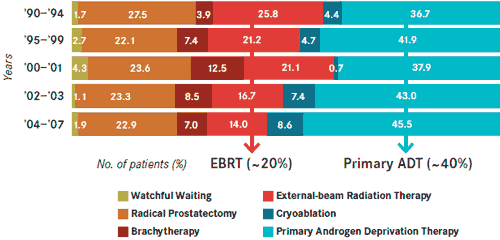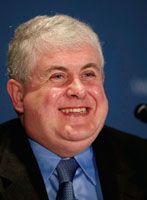Publication
Article
Oncology Live®
High-Risk Care Varies Widely
Author(s):
Many clinicians are not employing radiation therapy used in combination with androgen deprivation therapy even though guidelines suggest they should

Howard M. Sandler, MD
Radiation therapy (RT) used in combination with androgen deprivation therapy (ADT) continues to be a viable strategy for treating patients with localized, high-risk prostate cancer but many clinicians are not employing it—even though guidelines suggest they should.
Howard M. Sandler, MD, professor and chair of the Department of Radiation Oncology at Cedars- Sinai Medical Center in Los Angeles, California, made those points during the Interdisciplinary Prostate Cancer Congress held March 26 in New York City.
Sandler cited an analysis that Cooperberg et al conducted based on the Cancer of the Prostate Strategic Urologic Research Endeavor (CaPSURE) registry (J Clin Oncol. 2010;28(7):1117-1123) through 2007.
The researchers found the use of primary ADT for high-risk patients has risen to approximately 40%, while the use of external-beam RT declined to approximately 20%. High-risk patients, who comprise an estimated 15% to 25% of all prostate cancer patients, are most likely to die of the disease.
“It is kind of shocking to me that when you go all across the country that’s what people are getting,” Sandler said. “Primary hormonal therapy really should be used sparingly in these patients. It’s not a trivial effect adding radiation to these patients. The magnitude of benefit is on the order of radical prostatectomy for localized prostate cancer.”
Treatment Trends in High-Risk Patients

Adapted from Cooperberg MR, Broering JM, Carroll PR. Time trends and local variation in primary treatment of localized prostate cancer. J Clin Oncol. 2010;28(7):1117-1123.
Matthew R. Cooperberg, MD, MPH, an assistant professor of Urology at the University of California, San Francisco, said in an interview that guidelines support RT or surgery for high-risk patients, but there are few studies comparing outcomes across treatment options.
“The trend that many men with localized high-risk prostate cancer are not getting an opportunity at a cure is, I think, troubling,” said Cooperberg, noting that other studies found similar treatment patterns. “…I think both surgery and radiation therapy are underutilized. The fact is, men with high-risk disease very frequently need multimodal therapy.”
Padraig Warde, MCChB, a professor of Radiation Oncology at the University of Toronto in Canada, led a large National Cancer Institute of Canada study that established the benefits of combination RT and hormonal therapy for high-risk patients. After 7 years of follow-up, 74% of men who received the combination therapy were still alive, compared with 66% who received hormone therapy alone, the researchers found. (abstract CRA4504 from J Clin Oncol. 2010;28 [suppl 18]).
“I think it’s certainly a practice-changer, particularly in areas in which there was a lot of skepticism about the value of radiation in certain people,” Warde said.
Perspectives

Matthew R. Cooperberg, MD, MPH
Discrepancy between guidelines and community practice:
There is a huge amount of variation in terms of what actually gets done in community practice. There are some practices that do a lot of surgery. There are some practices that use frequent radiation therapy. Others favor brachytherapy, and still others cryotherapy. The guidelines endorse all of these as options because there have been few studies comparing them.
Aside from the instance of hormonal therapy for clinically localized disease, it’s hard to say that the practice is not consistent with the guidelines. It’s just that there is tremendous variation. The guidelines are, by necessity and sort of by definition, fairly vague because we don’t have many studies yet doing the kind of comparisons that need to be done.
Bias in treating older men:
In a screened population like the US, the older men are typically the ones with the worst tumors, and there really seems to be a very strong age bias in treatment. Older men are less likely to get local therapy whether it’s radiation or surgery. Older men are certainly least likely to get surgery, but it’s surprising how frequently they’re given only hormonal therapy. Obviously, there’s a strong role for hormonal therapy in conjunction with radiation therapy and for advanced disease. But using hormonal therapy as monotherapy for men with localized disease really is not supported by the evidence or by guidelines.

Padraig Warde, MCChB
Reasons for lack of comparative treatment evidence:
These studies are difficult. They’re expensive to conduct. When we conducted our study with 1200 patients, it took us 10 years to gather the [data]. And I think the trials are diffi cult to do because people have very definite ideas that they know the results of the treatments. Surgeons know that surgery is better. Radiation oncologists know that radiation is good, and there isn’t that level of inquiry that’s necessary.
His ongoing research into staging prostate cancer:
In general, we stage prostate cancer now based on three factors. One is what we call clinically, how the prostate feels on the rectal examination. We look at the Gleason score, which is under the microscope, and we look at the PSA level.
Those three factors are the same as when I went into practice in 1987 as a staff doctor. I’m hoping that we can develop new factors, such as factors under the microscope, genetic factors, epigenetic factors, new factors in the blood that can help us stage.










